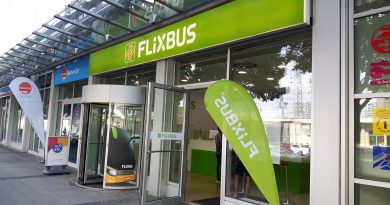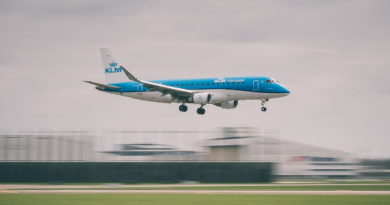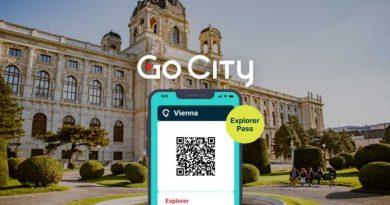From A to B with Ease: How It Helps You Navigate Europe’s Transport Network

Welcome to the vibrant world of Europe’s transport network! From bustling city streets to picturesque countryside, this diverse continent offers countless opportunities for exploration. Whether you’re planning a weekend getaway or embarking on an epic Eurotrip, navigating through unfamiliar territories can be both exciting and challenging.
Luckily, with the advent of A-to-B navigation apps, getting from point A to point B has never been easier. These handy tools provide real-time information on public transportation options, routes, and even pricing. So say goodbye to those frustrating moments of trying to decipher foreign bus schedules or struggling to find your way around intricate metro systems!
In this blog post, we’ll dive into the advantages of using A-to-B navigation apps while traveling in Europe. We’ll also explore some top-notch apps that will become your trusty travel companions along the way. So sit back, relax, and let technology guide you seamlessly through Europe’s vast transport network!
The Advantages of Using A-to-B Navigation Apps
When it comes to navigating Europe’s vast transportation network, there is no denying the advantages of using A-to-B navigation apps. These handy tools provide travelers with real-time information and efficient routes to get from point A to point B with ease.
One major advantage of using A-to-B navigation apps is the ability to access up-to-date information on public transportation schedules. Whether you’re traveling by train, bus, or metro, these apps can help you plan your journey and ensure that you don’t miss any connections. No more waiting around at stations or wondering when the next bus will arrive – simply check your app and stay on track.
Another advantage is the option for multi-modal transport planning. With an A-to-B navigation app, you can seamlessly combine different modes of transportation in one trip. Need to catch a train followed by a bus? The app will provide step-by-step directions so you know exactly where to go and when.
Additionally, these apps often offer alternative routes based on real-time traffic conditions. This feature is particularly useful if you’re driving or taking a taxi as it helps avoid congestion and minimizes travel time. Say goodbye to getting stuck in traffic jams!
Furthermore, many A-to-B navigation apps allow users to save their favorite destinations and create personalized profiles for even quicker route planning in the future. This feature proves especially helpful for frequent travelers who have specific locations they frequently visit.
Utilizing A-to-B navigation apps while navigating Europe’s transport network offers numerous advantages such as real-time schedule updates, multi-modal planning options, alternative routes based on traffic conditions, and personalized profiles for quick access to favorite destinations. So why not make your travels smoother by embracing technology? Download an A-to-B navigation app like Omio today!
Top A-to-B Navigation Apps for Travelers in Europe
When it comes to navigating the vast network of transportation options in Europe, having a reliable and user-friendly navigation app can make all the difference. With so many options out there, it can be overwhelming to choose the right one for your needs. That’s why we’ve compiled a list of some of the top A-to-B navigation apps that are perfect for travelers exploring Europe.
1. Omio: As an industry leader in travel planning and booking, Omio offers a comprehensive navigation app that covers trains, buses, and flights across multiple European countries. With its intuitive interface and real-time updates on routes and schedules, Omio makes it easy to plan your journey from start to finish.
2. Google Maps: One of the most widely used mapping apps worldwide, Google Maps is a go-to option for many travelers. It not only provides detailed directions but also offers information on public transportation options like buses and trains in major European cities.
3. Citymapper: Designed specifically with urban travelers in mind, Citymapper focuses on providing efficient routing within cities across Europe. It integrates data from various transport modes such as metro systems, buses, bikeshares, and even scooters to help you navigate through bustling city streets seamlessly.
4. Moovit: If you’re looking for a comprehensive app that covers public transit networks throughout Europe’s major cities, Moovit has got you covered. Its crowd-sourced data ensures accurate real-time updates on bus schedules as well as subway maps and walking directions.
5. HERE WeGo: Offering offline maps which are incredibly handy when traveling abroad without internet access or facing limited connectivity areas! Here WeGo provides turn-by-turn voice-guided navigation along with transit information including bus lines and train routes across numerous European destinations.
No matter which A-to-B navigation app you choose while exploring Europe’s transport network; always remember to check for regular updates, ensure you have a reliable internet connection or download offline maps.
Tips for Making the Most out of A-to-B Navigation Apps
1. Stay Connected: Make sure you have a reliable internet connection while using A-to-B navigation apps in Europe. This will ensure real-time updates and accurate information about routes, transportation options, and any changes or delays.
2. Plan Ahead: Before embarking on your journey, take some time to research the best route options and modes of transport available. Look for alternative routes or connections that may be more efficient or cost-effective.
3. Customize Your Preferences: Many A-to-B navigation apps allow you to customize your preferences based on factors such as cost, travel time, or mode of transport. Take advantage of these features to find the option that suits your needs best.
4. Explore Offline Options: Some navigation apps offer offline maps and directions, which can come in handy when you don’t have access to an internet connection while traveling through remote areas or underground transportation networks.
5. Real-Time Updates: Pay attention to real-time updates provided by the app regarding delays, disruptions, or changes in schedules. Being aware of any potential issues ahead of time can save you from unnecessary stress and help you adjust your plans accordingly.
6. Utilize Additional Features: Besides providing basic directions from point A to B, many navigation apps offer additional features like nearby attractions, restaurant recommendations, or public restroom locations along your route – take advantage of these extras to enhance your overall travel experience.
Remember that navigating Europe’s vast transportation network can be challenging at times but using an efficient A-to-B navigation app like Omio can greatly simplify the process! So make the most out of these tips and enjoy exploring all that Europe has to offer with ease!

The Future of A-to-B Navigation in Europe
The future of A-to-B navigation in Europe holds great promise and potential. With advancements in technology and the ever-increasing demand for seamless travel experiences, we can expect to see even more innovative features and improvements in the coming years.
One area that is likely to see significant development is real-time data integration. As cities continue to invest in smart infrastructure, navigation apps will be able to tap into a wealth of information, such as traffic patterns, public transportation schedules, and even weather conditions. This means users will have access to up-to-the-minute information that can help them make informed decisions about their journeys.
Another exciting aspect of the future of A-to-B navigation is the incorporation of augmented reality (AR). Imagine being able to hold up your phone or wearable device and instantly see directions overlaid onto the physical world around you. This could revolutionize how we navigate unfamiliar cities or find specific destinations within large transport hubs like airports or train stations.
Furthermore, machine learning algorithms will continue to evolve and improve over time. These algorithms can analyze user preferences, behavior patterns, and historical data to offer personalized recommendations for travel routes and transportation options. This level of personalization will not only save time but also ensure that each journey is tailored specifically to individual needs.
Additionally, as electric vehicles become more popular across Europe, A-to-B navigation apps may start incorporating EV charging station locations into their platforms. By providing this information upfront along with optimized routes that take into account charging times and availability, users can confidently plan long-distance trips without any range anxiety.
Lastly yet importantly, collaboration between different modes of transport providers will play a crucial role in shaping the future of A-to-B navigation. Integrating various transportation options seamlessly – from trains and buses to ride-sharing services like taxis or scooters – will further enhance travelers’ ability to navigate efficiently across Europe’s diverse landscapes.
In conclusion,tThe future looks bright for A-to-B navigation apps in Europe as they continue to evolve and adapt to the changing needs of travelers. With real-time data.
Our Recommendation: OMIO

In this fast-paced world, where time is of the essence, having a reliable and efficient way to navigate Europe’s vast transport network is essential for any traveler. A-to-B navigation apps have revolutionized the way we move from one place to another, making our journeys smoother and more enjoyable.
Among the top A-to-B navigation apps available, Omio stands out as a leader in simplifying travel planning across Europe. With its extensive coverage of various transportation options including trains, buses, and flights, Omio offers travelers a one-stop solution for all their transportation needs. Its user-friendly interface and intuitive features make it easy to find the best routes, compare prices, and book tickets conveniently.
By using A-to-B navigation apps like Omio, travelers can save valuable time and energy that would otherwise be spent on researching different modes of transportation or waiting in long queues at ticket counters. These apps provide real-time information on schedules, fares, and availability so that you can make informed decisions on your journey.
To make the most out of these navigation apps during your European adventures:
1. Download the app before your trip: Make sure you have the app installed on your smartphone with all necessary updates.
2. Enable notifications: Allow push notifications to receive important alerts about delays or changes in your itinerary.
3. Plan ahead: Take advantage of advanced booking options offered by these apps to secure better deals and guarantee seats.
4. Explore alternative routes: Use these navigation tools to discover lesser-known routes or hidden gems along your journey.
5. Stay connected: Ensure you have access to reliable internet connectivity while traveling so that you can use these apps seamlessly.
As technology continues to evolve rapidly around us, we can expect even more exciting developments in A-to-B navigation in Europe’s transport network. From incorporating artificial intelligence for personalized recommendations to integrating smart city initiatives for seamless transfers between different modes of transportations – there is no doubt that innovation will continue to shape the way we travel.



